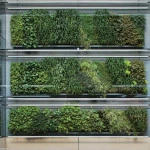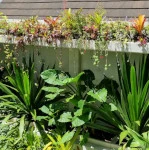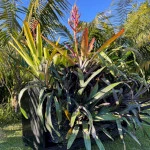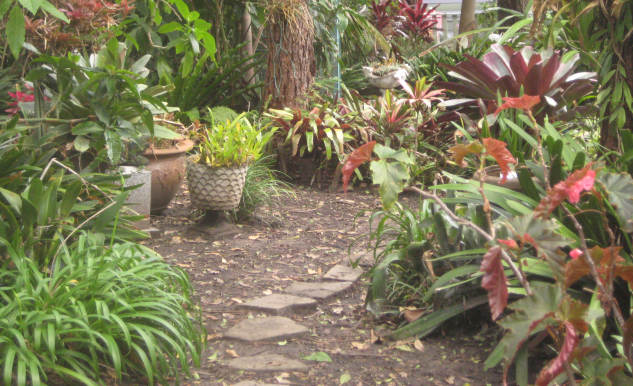Reclaiming the Built Environment – Where it all Began!
By Mark Paul, Founder of The Greenwall Company
Imagine a city in which buildings are clothed in soft swathes of green. A place where walls breathe and harsh lines disappear into sculpted beauty. Where sound is absorbed, air is cleaned, and biodiversity rules, as it has for thousands of years before man moved in.
My personal journey of discovery began in early childhood. At the age of two I was collecting worms and spiders. The whole natural world enthralled me. I saw and heard birds and reptiles, animals and plants. I was fascinated by their interactions, alarm calls, ecological niches and hiding places.
It is my strong belief that there is something about the human psyche that has driven humans to create gardens and collect plants. Our ancestors were plant gatherers and collectors. Our grandparents swapped and borrowed plants, cuttings and seeds from friends and neighbours, when times were tough and nurseries did not exist; or were simply too expensive.
When my Grandmother Redfern emigrated from Ireland in the early 1900s, she bought with her an acorn that she then grew in her garden in Windsor, at that time a rural area in New South Wales some hours away from Sydney. The acorn developed into a beautiful oak tree. All the trees and plants on her quarter-acre block were grown from cuttings, or seed, that were freely given (or ‘borrowed’) from someone’s garden.
That tradition of sharing plants continued with my immediate family who moved from rural Windsor to Newport Beach when I was two years old. From my grandmother’s garden we took seven species of bromeliads, along with many other cuttings and plants.
My mother, Nan Paul, brought plants and cuttings from her mother’s garden to Newport Beach and then began the work on her own garden. This garden was a battle-axe one-acre block on the slope of a rainforest gully. Here I delighted in chasing the koalas that were abundant in the area. This delight was short lived. Unfortunately, the septic tanks that we and our neighbours brought with us slowly killed or stunted the dry sclerophyll forests that had remained in the area despite earlier logging, which meant that there was declining food for the koalas. With the explosion of fences, dogs and other domestic pets the koalas disappeared.
However, in our garden, other native plants grew abundantly; these were the plants that preferred moist conditions. Turpentine trees, swathed in Cissus antartica provided shade and ferns covered the ground, the Greenhood orchids thrived. This plant community provided habitat for the insects, birds and small mammals. Clearing the bush and planting formal gardens of exotic plants and lawns was what everyone did. In the beginning my parents did the same. I remember that the family decided to grow a lawn around the house. In summer, the lawn grew and grew and grew; requiring two days of mowing each fortnight. This was a very large lawn. It took my father and me two days to cut the grass. Wanting to spend more time in the sea and on the beach than in mowing the lawns, I instigated a bush regeneration program in our backyard. I was still at primary school. I enlisted the help of my mother and we set about propagating the plants to make this a reality.
We used Tetra packs and tins as pots for the propagation. These we filled with sand. From the surrounding bush we collected old Banksia cones and old Hakea cones; then put the cones in the oven for about twenty minutes so we could release the seeds, and then scattered them into the sand filled pots. We poured some water into ice cream containers. We then sat the pots in the ice-cream containers. These provided a reservoir. A plastic bag over the top, secured with rubber bands provided a seal for the ‘greenhouse’. We propagated the whole garden this way. By the time I left high school, there was no lawn to be mown.
The built environment crept closer, and once again the habitat of flora and fauna changed. When the septic tanks (that had helped kill the koalas) were phased out and a mains connected sewerage system went in different trees took over. The trees that had previously lived thrived in the wet and ‘off the septic’ now died. The dry, schlerophytic trees that had struggled to survive got going again. At the same time the mangroves on the foreshores were either filled for landfill or dredged for deep-water boat and marina access for ‘waterfront’ housing.
So, I learnt very early on that how we live and how we use our land changes the environment. It is not always for the best. Later on, I learnt that we need to be smart and innovative in the way we grow plants and how we use our land. I also learnt that being innovative we also need to look to the past, to traditional practices. We also need to look at nature.
Today I run The Greenwall Company where we aspire to green cities. I have designed and implemented many gardens, both residential and commercial. There are a large number of factors that affect the process. They include; budget considerations, aspect, sight lines, clients likes and plant interest, maintenance, longevity and sustainability. Also, my own private gardens have given me much pleasure. They are more about process and experimentation and housing plants that are of interest to me, than fashionable design criteria.
My current garden is built into a sandstone escarpment in a Sydney suburb. I have used the natural flow of water to create a series of little wetlands; nurturing native plants, species collected from around the world, and many of them endangered flora. Nothing is wasted. Rainwater runs the whole system; fish and chickens and kitchen waste feed the whole garden. We have no green bin, all garden waste is used to mulch the garden, this breaks down naturally and nutrients are added to the soil. There is a herb and vegetable garden to educate the kids and begin the process once more of life education; just as grandmother’s garden was a beginning for me. A home for so many plants, including those that I have propagated myself, those that others have given me and, yes, event some plants from the gardens of my Grandmother and Mother. The tradition continues!





